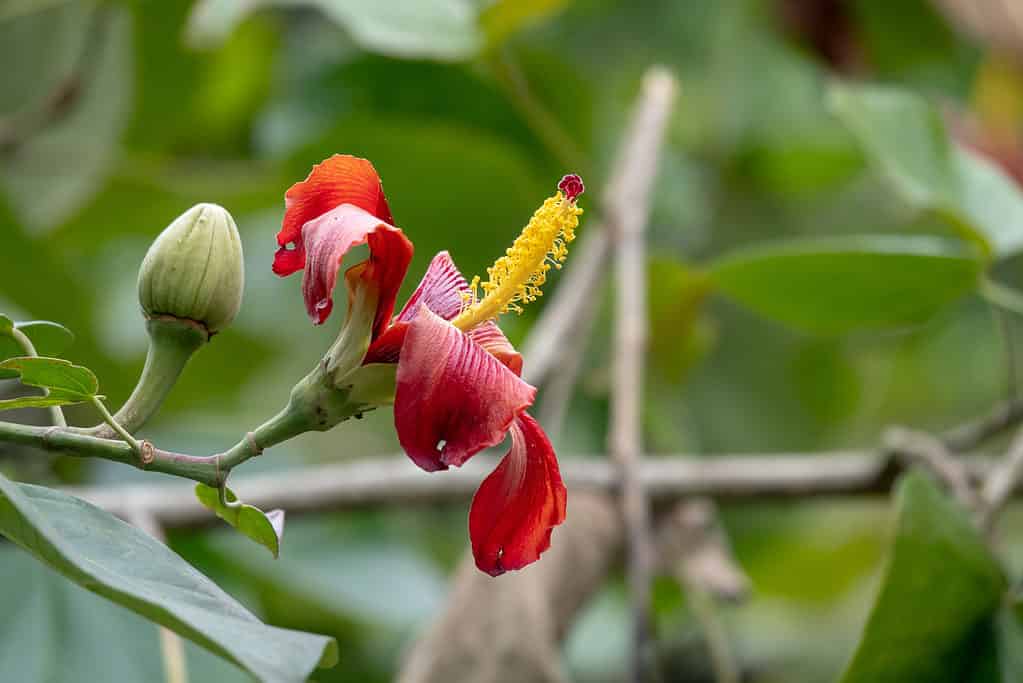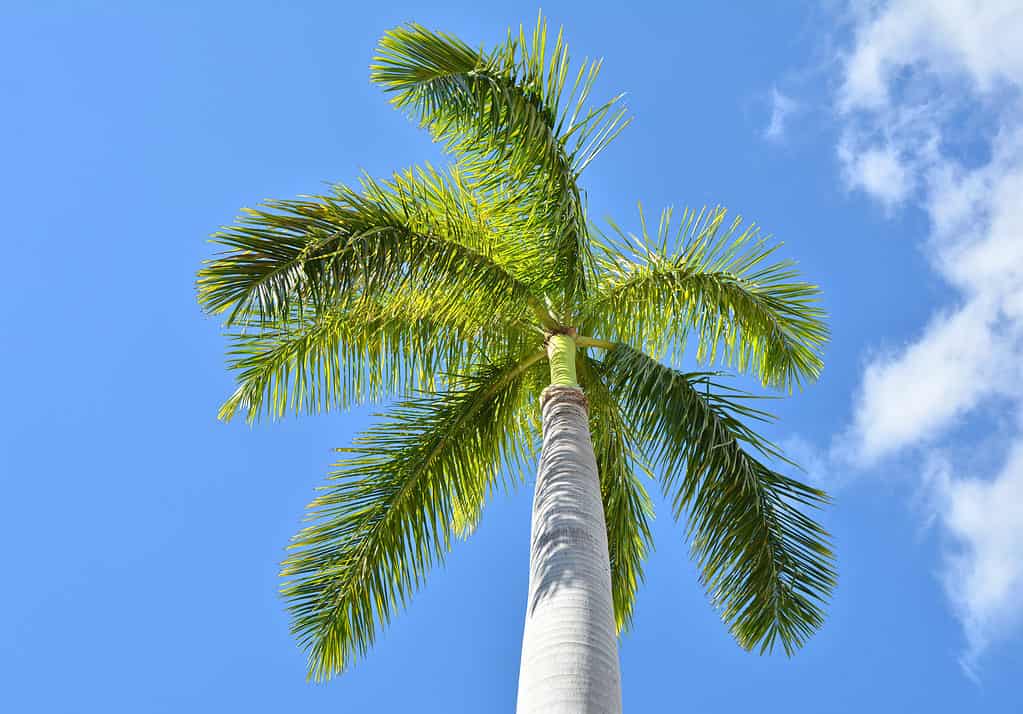Jamaica is a beautiful island that balances commerce with an amazing array of flora and fauna. Its mountains, wetlands, and plains make it ideal for a wide range of trees to flourish and support the ecosystem. Let’s discover more about the incredible trees native to Jamaica.
Where is Jamaica?

Kingston is the capital of Jamaica.
©snooooxxx/Shutterstock.com
Jamaica is an island in the Caribbean sea about 965 kilometers south of Florida. It’s part of the Great Antilles chain of Caribbean islands alongside Hispaniola, Puerto Rico, and Cuba.
It has a population of 2.8 million, and Kingston is its capital. Kingston is one of Jamaica’s two cities; the other is Montego Bay, a place very popular with tourists.
The island has a varied environment and climate. It’s mountainous in the center, with a coastal plain skirting the outer edge. Smack bang in the Atlantic Ocean hurricane belt, Jamaica receives more than its fair share of hurricane damage to its rainforests, wet limestone forests, woodlands, wetlands, and coral reefs. Although it’s tropical, humid, and hot, some parts of the island receive very little rainfall; for example, the Liguaena Plain is usually dry.
This mix of terrains and the varying climate means Jamaica has many interesting native trees. Here are 10 of them!
1. Podocarpus purdieanus
This conifer species sits in the Podocarpaceae family, but its common name is St. Ann yacca or simply yacca.
It’s an evergreen tree that can reach 131 feet (40 meters) tall with a spreading crown of deep green opposing pinnate leaves.
The yacca grows on limestone in thick coniferous forests and was used in the past to make ship masts and yam sticks. However, overharvesting, forest clearance, and mining operations have drastically reduced its population. Only a fragmented number grows in the central areas. It was declared endangered in 2013.
2. Talipariti elatum

The Blue Mahoe is Jamaica’s national tree.
©JIANG TIANMU/Shutterstock.com
Better known as Blue Mahoe, the Hibiscus Elatus is Jamaica’s national tree.
Its straight trunk can reach heights of 66 feet (20 meters) in wet areas with an elevation of 4,000 feet (1200 meters). Blue Mahoe gets its name from the blue-green streaks in its finished wood.
Blue Mahoe has broad dark green leaves and colorful hibiscus-like flowers. These beautiful blooms emerge bright yellow, turn orange, and finally turn dark red, serving pollinators throughout their lifetime.
3. Pimenta dioica
The pimento tree is known best for its dried fruits that make Allspice! The Pimento tree is native to the Jamaican mountains and is more commonly called Jamaican pepper.
It’s an evergreen tree in the myrtle family and has a white barked trunk with numerous branches over 40 feet tall. Deep green leaves (much like bay tree leaves) can also be used in cuisine to add rich flavors.
But the taste isn’t the only reason this tree is so loved. In summer, it has creamy white panicles of flowers that pollinators love.
4. Brya ebenus
Despite its status as a tree, Brya ebenus is a member of the Fabaceae pea family!
This incredible tree is native to Jamaica but has emerged in many other tropical places, such as South Asia. Over time, it has developed the name West Indian Ebony.
It’s a tropical beauty with rich green leaves and a trunk capable of reaching 30 feet tall. It’s fairly spiny, and its branches grow upwards and then cascade down as they mature, so it’s also called the Jamaican rain tree. They can live for hundreds of years, but sadly many don’t reach this grand old age because the timber (known as cocuswood) is highly prized for woodwind instruments and guitar fretboards.
Bright yellow flowers bloom in summer and grow on scrublands, bursting into flowers after rainstorms. Just beautiful.
5. Royal Palm

You can find royal palms all over Jamaica.
©Studio Barcelona/Shutterstock.com
It isn’t a list of incredible Jamaican trees without a palm!
The Royal Palm’s botanical name is Roystonea regia, and several species are native to the Caribbean islands.
When you think of a tropical palm, this is the type that springs to mind. It has a long clear gray-brown trunk that reaches 60 feet tall with a large crown of fanned green leaves. Some leaves reach four to five feet in length!
Royal palms are beneficial to the ecosystem. Bats and birds eat their fruits, then spread seeds around the island in their feces. Its flowers are a big draw for pollinators, and at night, the dense crown of leaves serves as a roosting point for birds, bats and all kinds of small amphibians.
6. Weinmannia portlandiana
This incredible tree is native to Jamaica’s wet tropical areas and is considered vulnerable to habitat destruction and logging.
It sits in the family Cunoniaceae alongside roughly 150 other species of Weinmannia, although the species Portlandiana is endemic to Jamaica.
Pinnate glossy green leaves with toothed margins are present all year round, and dangling racemes of white flowers that mature into capsule fruits appear in spring. The flowers and fruits provide food and an important habitat for birds, bats, frogs, and moths during their individual lifecycles.
7. Acaciella villosa
This unusual thorny scrub tree is native to Jamaica, Mexico and Peru. It’s a type of evergreen legume in the Fabaceae family that prefers the grasslands or plains of Jamaica but also grows in tropical wetlands because it’s so versatile.
Many people know it for the puffball white flowers held on short erect stems, but its foliage is fascinating too. It has pinnate leaves with a serrated edge that resembles a comb growing at right angles from its hairy branches.
This tree was used as a medical treatment for coughs and respiratory illnesses.
8. Calyptronoma occidentalis
This Jamaican tree was first described in 1797 by a Swedish botanist Olof Swartz.
It’s a palm with pinnate leaves that can reach 48 feet tall. It prefers to grow near waterlogged areas such as streams and swamps but with some elevation for humidity. Calyptronoma occidentalis has been recorded growing at 800 meters above sea level in its native Jamaica.
This palm has the honor of the longest rachillae in the calyptronoma genus. That means it has the longest flower-bearing spike!
9. Terminalia latofolia
This tree in the Combretaceae family is commonly known as the broadleaf. It’s a tall, straight Jamaican tree that can reach 65 feet in height with attractive brown bark and strong branches that grow horizontally from its main trunk. Its large mid-green leaves are evergreen, and after flowering, the tree produces fruits that resemble figs. Birds and small mammals make good use of this harvest!
The broadleaf prefers to grow in mountainous woodlands, and it was used to make barrels in the past. It was a large part of commercial Kingston, and although the broadleaf population is fragmented, thankfully, it’s not currently listed as vulnerable.
10. Psidium dumetorum
This Jamaican guava was a tree species in the Myrtaceae family and endemic to Jamaica.
None have been found since 1976, so experts think it’s extinct in the wild. A single final tree was noted growing in a thicket by a stream in Clarendon, Jamaica.
10 Incredible Jamaican Trees
These incredible trees of Jamaica are beautiful, but they also play an important role in the environment.
Jamaican trees reduce air pollution, protect the soil from erosion, and provide food, habitats, and shelter for all kinds of fauna, including birds, amphibians, insects, and mammals.
Some of the 10 incredible trees native to Jamaica are vulnerable, under threat of extinction, or have already disappeared due to human activities such as mining, logging, and ground clearance for crops.
It’s a timely reminder that we need to protect our planet. Trees are not optional – we need them to live.
Up Next
The photo featured at the top of this post is © snooooxxx/Shutterstock.com
Sources
- Red List / Accessed January 4, 2023
- Red List / Accessed January 4, 2023
- Royal Botanic Gaderns / Accessed January 4, 2023
- Visit Jamaica / Accessed January 4, 2023
Thank you for reading! Have some feedback for us? Contact the AZ Animals editorial team.







